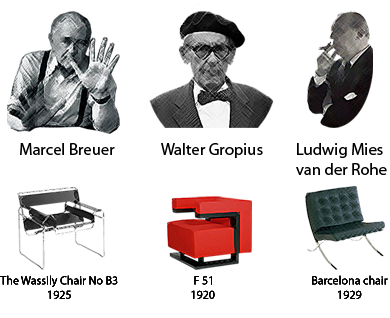
The word “bauhaus” translates in German to “house construction”. You pronounce the word “bou-hous”. Try and say Bauhaus out loud.
German architect, Walter Gropius, in the city of Weimar, Germany, formed a new school of art and design, The Bauhaus, in 1919. The Bauhaus brought together a group of talented and diverse instructors who embraced form and function of the machine. Bauhaus students searched for unique forms, creating works in which all of the arts, including architecture would contribute. First year studies included painting and material exploration followed by working with artists and craftsmen in years two and three. Designs originated from new building types, functional expression of materials, and construction methods. Connecting the artist to the craftsman, students studied architecture in both theory and practice. Students were encouraged to be creative thinkers as well as makers. The integration of all of the arts created new forms of visualization and building. Work from the Bauhaus influenced art, architecture, graphic design, interior design, industrial design and typography. Breaking with the past, Bauhaus teachers and students moved thinking into modern times.
In 1925, Gropius moved the school to Dessau, Germany and designed a series of buildings that still function as the Bauhaus today! The buildings express all of the principles of the Bauhaus approach. The use of material is straight forward. Interiors are comprehensively designed with operable windows, lighting, seating and furnishings. Even the door handles were designed to be utilitarian and beautiful. Besides building architectural structures, students and faculty focused on textile, wood, metal, color, glass, clay, and stone as materials for new construction ideas. The furniture, housewares, and lighting, contributed to the modern international style.
How does the Bauhaus curriculum compare to your school? Do you paint and work with materials to explore ideas?
Activity 1 – Form and Function

Even in the simplest of forms, forces are an important part to the success and longevity of a structure. The ability of a structure to hold the weight of different loads is a prime measure of safety to the builder, workers, and society. A non-moving load or dead load is the constant weight of a material and includes, but is not limited to, the weight of building materials or weight attached to the structure. A moving load or live load includes, but is not limited to, people, appliances, or vehicles. Live loads and dead loads become a variable that is used to find maximum loads a structure can hold.
Can you balance and build a card tower? What types of variables make it successful?
Activity 2 – Pronounce German words

A good way to practice a language is to say things out loud and extenuate the pronunciation. It is also helpful to surround yourself with others who are familiar with the language you are trying to learn.
Impress someone with a fact from the Bauhaus journey and use one of the words below!
Bauhaus = [ bou-hous ]
Breuer = [ BROY-er ]
Gropius = [ groh-pee-uhs ]
Mies = [ MEECE ]
van [ VAN ] der [ DER ] Rohe = [ ROE ]
Weimar = [ VY-mar ]
Dessau = [ DESS-ow ]
Activity 3 – research Bauhaus Masters
Coming Soon!
Activity 4 – Design like Kandinsky
Coming soon!
Review
- 1. The Bauhaus is founded in what European country?
- 2. How long did the Bauhaus school run?
- 3. Who founded the Bauhaus in 1919?
- 4. Mies van der Rohe believed that “less is _______”.
- 5. In Bauhaus buildings, what are the three main materials?
Explore
- BAUHAUS 1919-1933
- Bauhaus Dessau Foundation
- Dezeen Bauhaus A to Z
- Furniture by Marcel Breuer
- Gunta Stolzi
- Johannes Itten
- Josef and Anni Albers Foundation
- Lazlo Moholy Nagy
- Marcel Breuer
- Mies van der Rohe
- Paul Klee Timeline and SlideShow
- Tangents Modern Art to Architecture
- The Bauhaus History
- Walter Gropius
- Wassily Kandinsky Paintings Paris Web Museum



















































